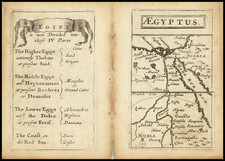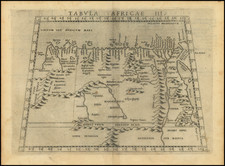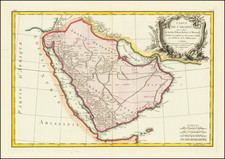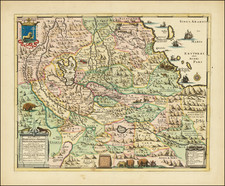Mapping the Suez at the End of the Eighteenth-Century
Highly-detailed map of the Suez Gulf, published by the Depot de la Marine in 1798, in the same year that Napoleon Bonaparte led the French campaign into Egypt and Syria.
This chart was based on the observations of skilled hydrographer and French naval officer, François Étienne de Rosily-Mesros, when he was surveying as commander of the Vénus in 1787. Seventy years later, the Suez Canal would terminate in this Gulf, connecting the Mediterranean and the Red Sea.
The chart outlines the Suez Gulf as it empties into the Red Sea. To the east is the Arabian Peninsula and to the west, Egypt. The shores on both sides are lined with mountains and high ground. The waters of the gulf are peppered with sounding depths, navigational obstructions, and anchorages.
Napoleon in Egypt
This chart was published in 1798, the same year that Napoleon led an army of soldiers and savants into Egypt and Syria. The Dépôt de la Marine likely released the chart in anticipation of or in conjunction with the expedition, although the surveying had occurred a decade earlier.
During the wars that followed the outbreak of the French Revolution, France sought to disrupt British naval dominance and their trade routes to India. Egypt, strategically located with ports on the Mediterranean and the Red Sea, became a strategic priority.
Bonaparte, fresh off his successful campaigns in Italy, was given command of the offensive against the Mamluks, who controlled the area as part of the Ottoman Empire. Along with squadrons of soldiers, 35,000 in all, Napoleon also brought with him a squadron of scholars, 160 in number. Called the Commission of the Sciences and Arts in Egypt, their work would kick up Egyptomania across Europe.
The French fleet landed in July and quickly took Alexandria. They then won the Battle of the Pyramids (Battle of Embabeh). However, these early victories proved to be the military highlight of the expedition. The French lacked the manpower to supply and hold a sufficient number of garrisons, forcing them to stay in and near Cairo and the Nile Delta. British ships decimated the French fleet in the Battle of the Nile in early August. Soon, local revolts and disease further stretched the French army. Napoleon left in 1799. His successors found no way forward and ultimately surrendered in Alexandria in September 1801.
While the martial goals of the campaign were not achieved, the scholarly effort was much more successful. The savants set up the Institute of Egypt in August 1798, which was to focus on mathematics, literature and fine arts, natural history and physics, and political economics (the Institute burned in 2011). The academics fanned out across the territory, gathering objects and making sketches.
One of them, Dominique-Vivant Denon, specialized in pharaonic monuments. He returned to France with Napoleon and began to write of his adventures and findings. In 1802, Denon published Travels in Lower and Upper Egypt, with was one of the most richly illustrated books to that time. The book ignited French popular interest in Egypt and its history, as well as rehabilitated Napoleon’s reputation after the failed campaign.
Napoleon might have left in 1799, but he sent even more academics into the region in search of antiquities. The return of many of these objects is now being debated and negotiated. When the French surrendered in 1801, these scholars were left stranded and facing British scrutiny. The British seized many objects, including the famous Rosetta Stone. They did eventually make it back to France with their notes, however, and they collectively embarked on an extraordinary project to share their work.
Napoleon ordered the commission to publish their findings in a massive book, the Description of Egypt. By 1809, 36 people were writing the text, with up to one hundred engravers creating illustrations, maps, and plans. There would eventually be 900 copper plates with 3,000 figures. The first volume appeared in that year, followed by 21 more: nine books of text and 13 of plates. The map volume was the last to be published, in 1828, as some of them had been considered sensitive information while the war raged. Today, at least twenty of the monuments illustrated in the Description are the best extant record of now-lost structures.
The Dépôt de la Marine, known more formally as the Dépôt des cartes et plans de la Marine, was the central charting institution of France. The centralization of hydrography in France began in earnest when Jean-Baptiste Colbert became First Minister of France in 1661. Under his watch, the first Royal School of Hydrography began operating, as did the first survey of France’s coasts (1670-1689). In 1680, Colbert consolidated various collections of charts and memoirs into a single assemblage, forming the core of sources for what would become the Dépôt.
The Dépôt itself began as the central deposit of charts for the French Navy. In 1720, the Navy consolidated its collection with those government materials covering the colonies, creating a single large repository of navigation. By 1737, the Dépôt was creating its own original charts and, from 1750, they participated in scientific expeditions to determine the accurate calculation of longitude.
In 1773, the Dépôt received a monopoly over the composition, production, and distribution of navigational materials, solidifying their place as the main producer of geographic knowledge in France. Dépôt-approved charts were distributed to official warehouses in port cities and sold by authorized merchants. The charts were of the highest quality, as many of France’s premier mapmakers worked at the Dépôt in the eighteenth century, including Philippe Bauche, Jacques-Nicolas Bellin, Rigobert Bonne, Jean Nicolas Buache, and Charles-François Beautemps-Beaupré.
The Dépôt continued to operate until 1886, when it became the Naval Hydrographic Service. In 1971, it changed names again, this time to the Naval and Oceanographic Service (SHOM). Although its name has changed, its purpose is largely the same, to provide high quality cartographic and scientific information to the France’s Navy and merchant marine.
François Étienne de Rosily-Mesros was born to the sea. The son of a naval officer, he entered the same profession at age fourteen, serving on Atlantic voyages as a garde de la marine. By 1772, he was an ensign and assigned to Yves-Joseph de Kerguelen-Trémarec’s expedition to find Terra Australis Incognita. While they did not locate the southern continent, they did find and name the Kerguelen Islands in the Indian Ocean.
His first command came in 1777 and he was promoted to lieutenant the next year. In the same year, he was part of a skirmish between French and English ships, resulting in his capture. He remained in England for twenty months, only gaining release in February 1780. Rosily shuffled between European and Indian Ocean waters. As captain, in 1784, Rosily took on the hydrographic work that would define the rest of his career. In the Vénus, Rosily surveyed coasts of Africa, the Red Sea, the Persian Gulf, and India. By 1790, he was named commander of the French naval division in India.
With the coming of the Revolution, Rosily was promoted rear admiral and given command of the navy at Rochefort. In 1795, he became director and inspector general of the Dépôt de la Marine. A year later he was promoted to vice admiral. As one of the highest-ranked officers in the fleet, Napoleon finally called on him in 1805, when Rosily was supposed to replace Admiral Villeneuve. Villeneuve instead sailed out of Cadiz, ultimately losing the famed Battle of Trafalgar. Now in command of the shattered remains of the French fleet, Rosily was blockaded in Cadiz. By 1808, he was surrounded by land and sea; Rosily had to surrender and return to France and the dépôt.
In his later years, Rosily was named a Count of the Empire and a member of the nation’s Bureau of Longitude. He also served as the President of the Council of Naval Constructions. In addition to his official charts, he was a prolific author and a free associate of the Académie des sciences. He died in 1832.









![[Map of the Persian Gulf]](https://storage.googleapis.com/raremaps/img/small/99842.jpg)




![[Ethiopia] Jobi Ludolfi Habessinia Seu Abassia Presbyteri Johannis Regio . . . MDCLXXXIII](https://storage.googleapis.com/raremaps/img/small/78394.jpg)